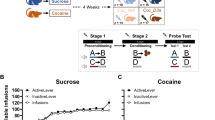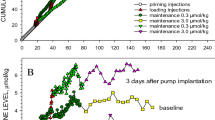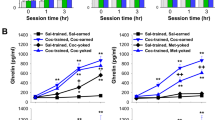Abstract
The role for corticotropin-releasing hormone (CRH) receptors in the maintenance of intravenous cocaine self-administration in rats was investigated using the centrally active, small molecule CRH1 receptor antagonist CP-154,526. In these experiments, adult male Wistar rats were allowed alternating 15-min periods of access to food reinforcement and cocaine self-administration (0.125, 0.25 or 0.5 mg/kg/infusion) during daily 2-h sessions. A 1-min timeout separated access to the two reinforcers. Pretreatment with CP-154,526 produced dose-related decreases in cocaine self-administration without affecting food-reinforced responding, suggesting a specific effect of the antagonist on cocaine-maintained behavior. Drug intake was decreased across several doses of cocaine, with the dose-response curve for cocaine self-administration shifted downward and flattened, suggesting that CP-154,526 decreased cocaine reinforcement. Furthermore, responding on the cocaine lever following CP-154,526 pretreatment was significantly suppressed, even during the first 15 min of the session, a time when rats typically sample the cocaine lever during extinction, suggesting that CRH receptors may also be involved in some of the conditioned effects of cocaine as well. These data are discussed in terms of the role for CRH in the neurobehavioral effects of cocaine.
Similar content being viewed by others
Log in or create a free account to read this content
Gain free access to this article, as well as selected content from this journal and more on nature.com
or
References
Ambrosio E, Sharpe LG, Pilotte NS . (1997): Regional binding to corticotropin releasing factor receptors in brain of rats exposed to chronic cocaine and cocaine withdrawal. Synapse 26: 272–276
Baker DA, Fuchs RA, Tran-Nguyen LT, Palmer AJ, Marshall JF, McPherson RJ, Neisewander JL . (1999): Cocaine-seeking behavior and Fos expression in the amygdala produced by cocaine or a cocaine self-administration environment. Ann NY Acad Sci 877: 796–799
Baumann MH, Gendron TM, Becketts KM, Henningfield JE, Gorelick DA, Rothman RB . (1995): Effects of intravenous cocaine on plasma cortisol and prolactin in human cocaine abusers. Biol Psychiatry 38: 751–755
Britton DR, Hoffman DK, Lederis K, Rivier J . (1984): A comparison of the behavioral effects of CRF, sauvagine and urotensin I. Brain Res 304: 201–205
Borowsky B, Kuhn CM . (1991): Monoamine mediation of cocaine-induced hypothalamo-pituitary-adrenal activation. J Pharmacol Exp Ther 256: 204–210
Cador M, Cole BJ, Koob GF, Stinus L, Le Moal M . (1993): Central administration of corticotropin-releasing factor induces long-term sensitization to D-amphetamine. Brain Res 606: 181–186
Caine SB, Heinrichs SC, Coffin VL, Koob GF . (1995): Effects of the dopamine D-1 antagonist SCH 23390 microinjected into the accumbens, amygdala or striatum on cocaine self-administration in the rat. Brain Res 692: 47–56
Cole BJ, Koob GF . (1989): Low doses of corticotropin-releasing factor potentiate amphetamine-induced stereotyped behavior. Psychopharmacology 99: 27–33
Cole BJ, Cador M, Stinus L, Rivier J, Vale W, Koob GF, Le Moal M . (1990): Central administration of a CRF antagonist blocks the development of stress-induced behavioral sensitization. Brain Res 512: 343–346
Deminiére JM, Taghzouti K, Tassin JP, Le Moal M, Simon H . (1988): Increased sensitivity to amphetamine and facilitation of amphetamine self-administration after 6-hydroxydopamine lesions of the amygdala. Psychopharmacology 94: 232–236
De Vries AC, Pert A . (1998): Conditioned increases in anxiogenic-like behavior following exposure to contextual stimuli associated with cocaine are mediated by corticotropin-releasing factor. Psychopharmacology 137: 333–340
De Vries AC, Taymans SE, Sundstrom JM, Pert A . (1998): Conditioned release of corticosterone by contextual stimuli associated with cocaine is mediated by corticotropin-releasing factor. Brain Res 786: 39–46
Dunn AJ, Berridge CW . (1990): Physiological and behavioral responses to corticotropin-releasing factor administration: is CRF a mediator of anxiety or stress responses? Brain Res Rev 15: 71–100
Erb S, Shaham Y, Stewart J . (1998): The role of corticotropin-releasing factor and corticosterone in stress- and cocaine-induced relapse to cocaine seeking in rats. J Neurosci 18: 5529–5536
Gardi J, Biro E, Sarnyai Z, Vecsernyes M, Julesz J, Telegdy G . (1997): Time-dependent alterations in corticotropin-releasing factor-like immunoreactivity in different brain regions after acute cocaine administration to rats. Neuropeptides 31: 15–18
Goeders NE, Smith JE . (1983): Cortical dopaminergic involvement in cocaine reinforcement. Science 221: 773–775
Goeders NE, Bienvenu OJ, De Souza EB . (1990): Chronic cocaine administration alters corticotropin-releasing factor receptors in the rat brain. Brain Res 531: 322–328
Goeders NE, Smith JE . (1993): Intracranial cocaine self-administration into the medial prefrontal cortex increases dopamine turnover in the nucleus accumbens. J Pharmacol Exp Ther 265: 592–600
Goeders NE, Guerin GF . (1996): Role for corticosterone in intravenous cocaine self-administration in rats. Neuroendocrinology 64: 337–348
Goeders NE . (1997): A neuroendocrine role in cocaine reinforcement. Psychoneuroendocrinology 22: 237–259
Goeders NE, Peltier RL, Guerin GF . (1998): Ketoconazole reduces low dose cocaine self-administration in rats. Drug Alcohol Dependence 53: 67–77
Goeders NE, Clampitt D, Peltier RL, Guerin GF . (2000): Reinstatement of cocaine-seeking behavior using a conditioned reinforcer: Role for the hypothalamo-pituitary-adrenal (HPA) axis. In Harris LS (ed), NIDA Research Monograph, Problems of Drug Dependence, 1999, NIH Publication 00–4737. Bethesda, MD, NIH, p 92
Hurd YL, McGregor A, Ponten M . (1997): In vivo amygdala dopamine levels modulate cocaine self-administration behaviour in the rat: D1 dopamine receptor involvement. Eur J Neurosci 9: 2541–2548
Kalivas PW, Duffy P, Latimer G . (1987): Neurochemical and behavioral effects of corticotropin-releasing factor in the ventral tegmental area of the rat. J Pharmacol Exp Ther 242: 757–763
Koob GF, Goeders NE . (1989): Neuroanatomical substrates of drug self-administration. In Liebman JM, Cooper SJ (eds), Oxford Reviews in Psychopharmacology, Vol. 1, Neuropharmacological Basis of Reward. London, Oxford University Press, pp 214–263
Koob GF, Bloom FE . (1988): Cellular and molecular mechanisms of drug dependence. Science 242: 715–723
Mansbach RS, Brooks EN, Chen YL . (1997): Antidepressant-like effects of CP-154,526, a selective CRF1 receptor antagonist. Eur J Pharmacol 323: 21–26
Mantsch JR, Goeders NE . (1999): Ketoconazole blocks the stressor-induced reinstatement of cocaine-seeking behavior in rats: relationship to the discriminative stimulus effects of cocaine. Psychopharmacology 142: 399–407
McCarthy JR, Heinrichs SC, Grigoriadis DE . (1999): Recent advances with the CRF1 receptor: design of small molecule inhibitors, receptor subtypes and clinical implications. Cur Pharmacol Design 5: 289–315
Meil WM, See RE . (1997): Lesions of the basolateral amygdala abolish the ability of drug associated cues to reinstate responding during withdrawal from self-administered cocaine. Behav Brain Res 87: 139–148
Mendelson JH, Mello NK, Teoh SK, Ellingboe J, Cochin J . (1989): Cocaine effects on the pulsatile secretion of anterior pituitary, gonadal, and adrenal hormones. J Clin Endocrinol Metab 69: 1256–1260
Moldow RL, Fischman AJ . (1987): Cocaine induced secretion of ACTH, beta-endorphin, and corticosterone. Peptides 8: 819–822
Peltier RL, Guerin GF, Dorairaj NR, Irby BD, Goeders NE . (1999): The effect of saline substitution tests on plasma corticosterone in rats trained to self-administer cocaine. In Harris LS (ed), NIDA Research Monograph, Problems of Drug Dependence, 1998. NIH publication 99–4395. Bethesda, MD, NIH, p 254
Piazza PV, Rougé-Pont F, Deminiére JM, Kharoubi M, Le Moal M, Simon H . (1991): Dopaminergic activity is reduced in the prefrontal cortex and increased in the nucleus accumbens of rats predisposed to develop amphetamine self-administration. Brain Res 567: 169–174
Richter RM, Merlo Pich E, Koob GF, Weiss F . (1995): Sensitization of cocaine-stimulated increase in extracellular levels of corticotropin-releasing factor from the rat amygdala after repeated administration as determined by intracranial microdialysis. Neurosci Lett 187: 169–172
Richter RM, Weiss F . (1999): In vivo CRF release in rat amygdala is increased during cocaine withdrawal in self-administering rats. Synapse 32: 254–261
Rivier CL, Vale W . (1987): Cocaine stimulates adrenocorticotropin (ACTH) secretion through a corticotropin-releasing factor (CRF)-mediated mechanism. Brain Res 422: 403–406
Rivier C, Lee S . (1994): Stimulatory effects of cocaine on ACTH secretion: role of the hypothalamus. Mol Cell Neurosci 5: 189–195
Sarnyai Z, Biro E, Penke B, Telegdy G . (1992a): The cocaine-induced elevation of plasma corticosterone is mediated by endogenous corticotropin-releasing factor (CRF) in rats. Brain Res 589: 154–156
Sarnyai Z, Hohn J, Szabo G, Penke B . (1992b): Critical role of endogenous corticotropin-releasing factor (CRF) in the mediation of the behavioral action of cocaine in rats. Life Sci 51: 2019–2024
Sarnyai Z, Biro E, Gardi J, Vecsernyes M, Julesz J, Telegdy G . (1993): Alterations of corticotropin-releasing factor-like immunoreactivity in different brain regions after acute cocaine administration in rats. Brain Res 616: 315–319
Sarnyai Z, Mello NK, Mendelson JH, Eros-Sarnyai M, Mercer G . (1996): Effects of cocaine on pulsatile activity of the hypothalamic-pituitary-adrenal axis in male rhesus monkeys: neuroendocrine and behavioral correlates. J Pharmacol Exp Ther 277: 225–234
Schulz DW, Mansbach RS, Sprouse J, Braselton JP, Collins J, Corman M, Dunaiskis A, Faraci S, Schmidt AW, Seeger T, Seymour P, Tingley FD, Winston EN, Chen YL, Heym J . (1996): CP-154,526: a potent and selective nonpeptide antagonist of corticotropin releasing factor receptors. Proc Natl Acad Sci USA 93: 10477–10482
Shaham Y, Funk D, Brown TJ, Walker C-D, Stewart J . (1997): Corticotropin-releasing factor, but not corticosterone, is involved in stress-induced relapse to heroin-seeking in rats. J Neurosci 17: 2605–2614
Shaham Y, Erb S, Leung S, Buczek Y, Stewart J . (1998): CP-154,526, a selective non-peptide antagonist of the corticotropin-releasing factor1 receptor attenuates stress-induced relapse to drug-seeking behavior in cocaine- and heroin-trained rats. Psychopharmacology 137: 184–190
Teoh SK, Sarnyai Z, Mendelson JH, Mello NK, Springer SA, Sholar JW, Wapler M, Kuehnle JC, Gelles H . (1994): Cocaine effects on pulsatile secretion of ACTH in men. J Pharmacol Exp Ther 270: 1134–1138
Weiss SR, Nierenberg J, Lewis R, Post RM . (1992): Corticotropin-releasing hormone: potentiation of cocaine-kindled seizures and lethality. Epilepsia 33: 248–254
Whitelaw RB, Markou A, Robbins TW, Everitt BJ . (1996): Excitotoxic lesions of the basolateral amygdala impair the acquisition of cocaine-seeking behaviour under a second-order schedule of reinforcement. Psychopharmacology 127: 213–224
Yang XM, Gorman AL, Dunn AJ, Goeders NE . (1992): Anxiogenic effects of acute and chronic cocaine administration: neurochemical and behavioral studies. Pharmacol Biochem Behav 41: 643–650
Zhou Y, Spangler R, LaForge KS, Maggos CE, Ho A, Kreek MJ . (1996): Corticotropin-releasing factor receptor messenger RNAs in rat brain and pituitary during “binge”-pattern cocaine administration and withdrawal. J Pharmacol Exp Ther 279: 351–358
Acknowledgements
We thank Dr. Robert Mansbach of Pfizer Central Research, Groton, CT, for the generous gift of CP-154,526. This research was supported by USPHS grant DA06013 from the National Institute on Drug Abuse.
Author information
Authors and Affiliations
Corresponding author
Rights and permissions
About this article
Cite this article
Goeders, N., Guerin, G. Effects of the CRH Receptor Antagonist CP-154,526 on Intravenous Cocaine Self-administration in Rats. Neuropsychopharmacol 23, 577–586 (2000). https://doi.org/10.1016/S0893-133X(00)00148-2
Received:
Revised:
Accepted:
Issue date:
DOI: https://doi.org/10.1016/S0893-133X(00)00148-2
Keywords
This article is cited by
-
Effects of a methamphetamine vaccine, IXT-v100, on methamphetamine-related behaviors
Psychopharmacology (2020)
-
Prevention and reversal of social stress-escalated cocaine self-administration in mice by intra-VTA CRFR1 antagonism
Psychopharmacology (2017)
-
Adaptations in brain reward circuitry underlie palatable food cravings and anxiety induced by high-fat diet withdrawal
International Journal of Obesity (2013)
-
Role of kappa-opioid receptors in stress and anxiety-related behavior
Psychopharmacology (2013)
-
Adrenal Activity during Repeated Long-Access Cocaine Self-Administration is Required for Later CRF-Induced and CRF-Dependent Stressor-Induced Reinstatement in Rats
Neuropsychopharmacology (2011)



